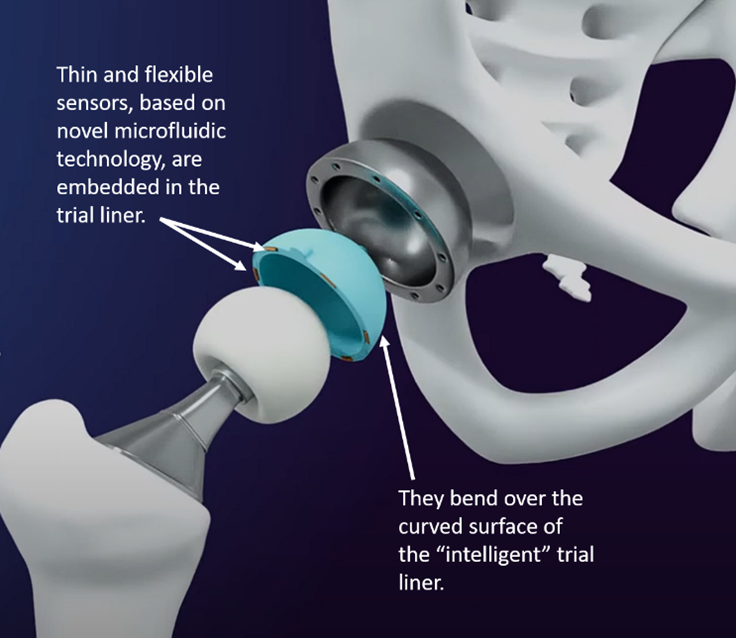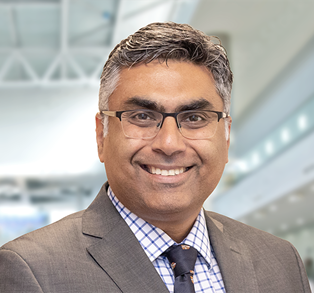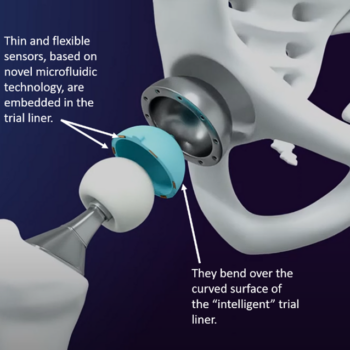Team’s hip replacement surgery invention is set to be world first
Technology which is the first of its kind in the world and could transform the future of hip replacement surgery is being pioneered by a team of experts in Cambridge.
They have just won a major award to further develop their breakthrough technology, which aims to make hip surgery more precise and deliver better and longer-lasting outcomes – which is good for patients and the NHS.
The National Institute for Health and Care Research (NIHR) has awarded a £1.4 million Invention for Innovation (i4i) Product Development Award to advance work on the team’s “smart” joint “trial liner”.
Thin and flexible sensors, based on novel microfluidic technology developed in the University of Cambridge’s (UoC’s) Department of Materials Science and Metallurgy, are embedded in the trial liner.
The sensors measure forces passing through the joint to help the surgeon assess and balance the soft tissues, which aids the accurate positioning of the implant.
Once measurements are complete using the wireless surgical aid, the surgeon marks the ideal position for the implant, removes the smart trial liner, and completes the operation.

There are currently no technologies that can deliver such readings during an operation and in real-time, and instead surgeons “balance” the joint based on “feel” and anatomical landmarks.
This is despite over two million total hip replacements (THRs) being performed annually, with the number constantly rising due to increasing lifespans, says the team.
The patient demographic is also shifting towards the young, so implants need to withstand higher stresses, and last longer, to avoid spiralling into a vicious circle of revision surgery and higher rates of dissatisfaction.
Driving this clinical initiative is chief investigator Professor Vikas Khanduja (pictured below), who is also consultant orthopaedic surgeon at Cambridge University Hospitals and clinical and research lead of the Young Adult Hip Service.
The technology development is being overseen by UoC Professor of device materials, Prof. Sohini Kar-Narayan, together with UoC biophysicist and translational scientist, Dr Jehangir Cama, who is leading on translational and commercialisation activities. They are joined by Consultant clinical scientist and CUH head of clinical engineering, Prof. Paul White.
Prof. Kar-Narayan said: “It has been a truly exciting journey so far in designing and developing a novel force sensing technology in my lab with a fantastic and dedicated team, resulting in a prototype device that can potentially measure and help balance forces during total hip replacement surgeries.
“The team is really looking forward to this next phase of product development that will see us move towards an actual product that is fit for clinical use, and that has the potential to revolutionise joint replacement surgery.”
Dr Cama added: “We are delighted and extremely grateful to see our years of work rewarded with this major translational grant from NIHR. The funding will bring together wide-ranging expertise to help us further develop our prototype, thereby bringing this novel technology ever closer to clinical use.”
Also giving expert input are NIHR Cambridge Biomedical Research Centre science communication and patient/public engagement strategist, Dr Amanda Stranks, UoC’s Office for Translational Research, and commercialisation director of Cambridge Enterprise Limited, Dr Terry Parlett.

The team currently has a prototype version of the device, which has been validated in the laboratory and in other tests. However, the NIHR award is pivotal in further developing and finalising the design and complying with regulations before it can be tested in a living patient.
Professor Khanduja, pictured left, who in 2021 was awarded the Hunterian Professor Award for innovative work, said: “We are incredibly grateful to the NIHR for this grant and extremely proud to have won it.
“It will fund a two-year project to help us collect the data needed to complete key product development milestones to further this technology’s path out of the lab and into the clinic.”
The team’s underlying sensor technology intellectual property has been protected via a patent application filed by Cambridge Enterprise, which lists Prof. Kar-Narayan, Mr Khanduja, and Dr Cama amongst its inventors.
Together with business partner and translational expert Dr Alex Samoshkin, they have also incorporated ‘ArtioSense Limited’ as the potential commercialisation vehicle for the technology.
Prof. Miles Parkes, director of the NIHR Cambridge Biomedical Research Centre said: “The project has strong support through our BRC’s new ‘Medical Device’ theme.
“It has the potential to deliver a sophisticated technical solution to a major clinical need and represents a complex collaboration between surgeons and Clinical Engineering Innovation at Addenbrooke’s Hospital, a local subcontractor, Springboard, which specialises in device development, the Department of Material Sciences and Metallurgy in the University of Cambridge and the Office for Translational Research.
“We are delighted to see it launching and wish the research team every success.”
Dr Terry Parlett, commercialisation director at Cambridge Enterprise, said: “The awarding of this grant will provide a tremendous boost to help bring this innovative technology from bench to bedside.
“This is a fantastic example of Cambridge’s entrepreneurial clinicians, academics and their institutions working together with forward-looking funders to create a positive impact for markets, society and importantly patients.”
Dr Silvana Cossins, NIHR i4i senior programme manager, said: “We are pleased to support this innovative project that aims to benefit patients undergoing hip replacements. We look forward to engaging with Mr Khanduja, Prof. Kar-Narayan, Dr Cama and the rest of the project team over the course of the award to make this project a success.”
The NIHR Invention for Innovation (i4i) Programme is a translational research funding scheme aimed at medical devices, in vitro diagnostic devices, and digital health technologies addressing an existing or emerging health or social care need. More about it is available via this webpage.
ArtioSense have produced a video about this exciting technology: watch it here:



